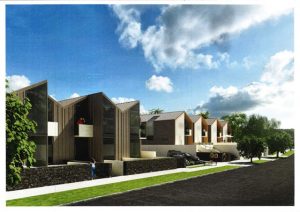Noise, vibration, dust and heavy traffic will be the main worries for neighbours as contractors head towards a start on the Housing NZ land at 33 Asquith Ave.
Preparation work is due to begin on February 7 and an uneven site sitting on a volcanic rock base will pose challenges to the developers.
But people living around the 8094sq m block, including elderly folk in the units along the eastern perimeter, will have their own headaches. Dust is inevitable, and the noise and vibration from rock-breaking and heavy machinery will test their patience.
 There are rules that must be followed, though, and Housing NZ will have a community liaison officer to whom breaches can be reported.
There are rules that must be followed, though, and Housing NZ will have a community liaison officer to whom breaches can be reported.
The resource consent decision sums it up this way: “Adverse effects on the neighbouring properties arising from the proposed excavation, rock-breaking and construction will be temporary in nature and can be appropriately managed.”
Under the consents, the rock-breaking work can be done only between 7.30am-6pm, Monday to Friday, and 7.30am-1pm on Saturdays. Decibel levels must be 80 or lower – with a maximum spike to 95 decibels – measured 1m from the façade of any occupied building.
How loud is 80 decibels? Bad enough if it’s your neighbour mowing the lawn outside your window, but very intrusive if it bangs on for six or eight hours, day after day, with peaks rising sharply higher.
For other construction work at Asquith, the consents demand lower decibel levels:
– Weekdays: 6.30am-7.30am (55 decibels, with maximum spike of 75 decibels); 7.30am-6pm (70/85); 6pm-8pm (65/80); 8pm-6.30am (45/75).
– Saturdays, 7.30am-6pm (70 decibels, with maximum spike of 85 decibels); 6pm-7.30am (45/75).
– Sundays and public holidays: 7.30am-6pm (55 decibels, with maximum spike of 85 decibels); 6pm-6.30am (45/75).
Time will tell whether the excavation and rock-breaking can indeed be “appropriately managed”, but the contractors are required to prepare, implement and monitor a “construction noise and vibration management plan”. All the work will be subject to close scrutiny and decibel readings to make sure limits are not exceeded.
Housing NZ initially hoped the levelling and rock-breaking might be completed within a couple of weeks but planners suggest that target – dealing with volcanic rock – may be optimistic and the resource consent makes reference to “longer than 15 days”.
A provision in the consent documents for a communication plan if the rock-breaking takes more than four weeks gives a clue to the uncertain nature of the work.
It could be that locals are in for three weeks and more of heavy machinery, trucks, drilling, blasting and dust over the late summer before the pre-building infrastructure is tackled. That work will include connecting power and water to the block; handling waste water/stormwater; establishing detention water tanks; preparing for driveways and stormwater; landscaping, removing and planting trees; capping existing services, and installation of fibre.
Bruce Morris







